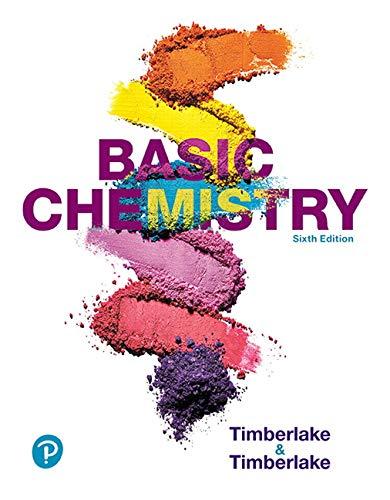
Concept explainers
The chapter sections to review are shown in parentheses at the end of each problem.
In which of the following pairs do both numbers contain the same number of significant figures? (2.2)
To determine: The pairs of numbers that contain the same number of significant figures
Answer to Problem 83UTC
Solution:
c) 0.000 75 s and 75 000 s
d) 6.240 L and 6.240 × 10-2 L
Explanation of Solution
A number is significant if it is:
- Non-zero digit.
- Any zeros between two or more non-zero digits.
- Trailing zeroes in the decimal number.
Also, note that zero placed after a non-zero digit without any decimal is simply a place holder and insignificant. Therefore, as per the above rules one can write:
a)
| Number | Significant Figures |
| 2.0500 m | 5 |
| 0.0205 m | 3 |
b)
| Number | Significant Figures |
| 600.0 K | 4 |
| 60 K | 1 |
c)
| Number | Significant Figures |
| 0.000 75 s | 2 |
| 75 000 s | 2 |
d)
| Number | Significant Figures |
| 6.240 L | 4 |
| 6.240 × 10-2 L | 4 |
The pairs of numbers in (c) and (d) have the same significant figures.
Want to see more full solutions like this?
Chapter 2 Solutions
Basic Chemistry Plus Mastering Chemistry With Pearson Etext -- Access Card Package (6th Edition)
- 1,3,5 what the correct answer?arrow_forwardCalculate the Ka of X in chloroform. Answèr in 4 significant figures.arrow_forwardCompare picture I and II and choose: A = If the indicated property is greater in picture I than in II B = If the indicated property is less in picture I than in II C = If the indicated property is equal in both picture D = If no comparison can be made due to insufficient information pKaarrow_forward
- AP BIO (1) An analytical balance is used to measure the mass of 200µl of water in triplicate. The following measurements are recorded: 0.1983g, 0.1990g, 0.1884g. (A) Calculate the mean value for these three mass determinations. 0.1952 g (B) Use the mean value from (A) to determine the percent error.. 19.52% ???arrow_forward10 Not sure if calculated correctlyarrow_forwardCalculate the percent difference between x2 and x4 according to the equation below. (Assume x2 to be the accepted value.) Record the calculation in your notes. x2 = 100.4 kJ x4 = -100.4 kJ %difference = experimental value - accepted value x 100% accepted valuearrow_forward
- Nitrous oxide (N₂O), also known as laughing gas, has uses in surgery and dentistry as an anesthetic. What is the molecular weight of nitrous oxide (N₂O)? Provide an answer to two decimal places.arrow_forwardGyuri performed an analysis of Simvastatin tablets. The following are the data she obtained: 39.5 mg, 41.2 mg, 40.7 mg, 38.9 mg, 42.1 mg, 41.7 mg, 38.7 mg Suppose the mg of Simvastatin stated in label is 40 mg, is there a significant difference between her results and the label claim?arrow_forwardMr. Naresh works in a multinational company. He is stressed due to his hectic schedule. Mr. Amit, his friend, comes to know that he has started taking sleeping pills without consulting the doctor. Mr. Amit requests ‘ Naresh to stop this practice and takes him to a Yoga centre. With regular Yoga sessions, Mr. Naresh is now a happy and relaxed man. ‘ After reading the above passage, answer the following questions: (i) Write the values shown by Mr. Amit. (ii) Which class of drugs is used in sleeping pills? (iii) Why is it not advisable to take sleeping pills without consultation with the doctor?arrow_forward
- In a survey of 1000 large corporations, 250 said that, given a choice between a job candidate who smokes and an equally qualified nonsmoker, the nonsmoker would get the job (USA Today).(a) Let p represent the proportion of all corporations preferring a nonsmoking candidate. Find a point estimate for p.(b) Find a 0.95 confidence interval for p.(c) As a news writer, how would you report the survey results regarding the proportion of corporations that hire the equally qualified nonsmoker? What is the margin of error based on a 95% confidence interval?arrow_forwardA patient is prescribed Tiguan capsules for vomiting. The drug is available in the form of 3.0 x 10 ^2 mg Tigan/capsule and is to be administered in 4.0 doses/day. 1 dose is equal to 1 capsule. How many grams of tigan does the patient receive in 2.0 days ? Show your workarrow_forwardWhich of the following pairs have a relationship that is most similar to composition? Group of answer choices 1.A toy car and Car. 2.A car and an engine. 3.A Honda Civic and Car. 4.A lock and a key.arrow_forward
 Chemistry & Chemical ReactivityChemistryISBN:9781133949640Author:John C. Kotz, Paul M. Treichel, John Townsend, David TreichelPublisher:Cengage Learning
Chemistry & Chemical ReactivityChemistryISBN:9781133949640Author:John C. Kotz, Paul M. Treichel, John Townsend, David TreichelPublisher:Cengage Learning
